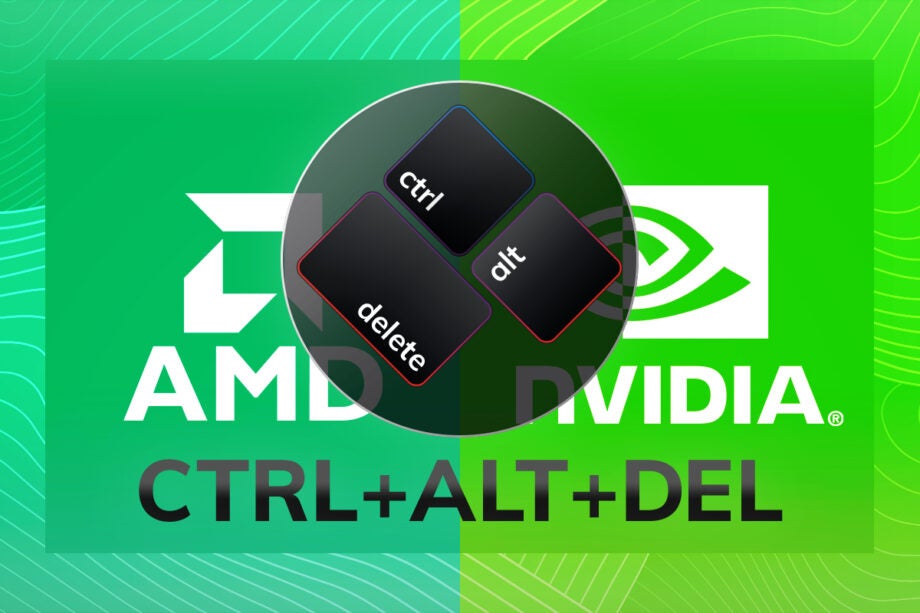Ctrl+Alt+Delete: AMD can’t compete with Nvidia without a DLSS rival

AMD has just announced the RX 6700 XT, which is the 4th graphics card of the Big Navi generation. But, despite all the fanfare, there’s still no sign of AMD’s competitor to DLSS, which in my mind, is a deal breaker.
While AMD has so far done an excellent job of rivalling Nvidia’s graphics cards in terms of raw performance, the lack of a DLSS solution means AMD’s cards struggle to run modern games at a high frame rate when ray tracing is activated.
Take the Radeon RX 6900 XT for example. With ray tracing turned off, it excelled as a 4K graphics card in our testing, comfortably surpassing 60fps in the majority of games. But as soon as we activated ray tracing, the RX 6900 XT performance dropped down below 30fps for the likes of Control and Battlefield V.
The below table shows how beneficial DLSS can be for Nvidia graphics cards when ray tracing enters the fray, pushing the frame rate up by an impressive 31fps when playing Control. In comparison, AMD’s RX 6900 XT card struggles to juggle both ray tracing and a 4K performance simultaneously, which is a concern since these are the GPU’s flagship features.
| Control in 4K Ray tracing off |
Control in 4K Ray tracing on and DLSS off |
Control in 4K Ray tracing and DLSS on |
|
| AMD RX 6900 XT | 57fps | 28fps | NA |
| Nvidia RTX 3080 | 107fps | 32fps | 63fps |
While we haven’t been able to test the newly announced RX 6700 XT just yet, the new graphics card will likely face the same issue when gaming in Quad HD resolutions. It says a lot that AMD refrained from sharing ray tracing benchmark results in the launch video, as the Nvidia RTX 3070 will likely offer far superior results with the feature activated.
Of course, ray tracing isn’t the be all and end all of the new generation of graphics cards, especially since many new games still don’t support the advanced light-rendering technology. However, when Nvidia’s RTX 3070 card costs just $20 more than the new RX 6700 XT, the omission of such a major feature can’t go unnoticed.
The good news for AMD is that a DLSS competitor is already in the works. AMD even has a name for it: FidelityFX Super Resolution. However, AMD has been very quiet on the technology in recent events, with a launch date yet to be confirmed.
Website Prohardver (via VideoCardz) suggests AMD plans to release a big driver update this Spring, which could mean the FidelityFX Super Resolution’s arrival could be imminent. That said, the fact this major driver update wasn’t mentioned during the RX 6700 XT presentation makes us less hopeful.
And even if AMD does launch the FidelityFX Super Resolution this month, there’s no guarantee it’ll be as effective as Nvidia’s DLSS straight away. Nvidia originally launched DLSS back in February 2019, and the first iteration had a lot of issues such as visual downgrades. It has since launched DLSS 2.0, which is far more effective at producing accurate, upscaled images.
If it took Nvidia two years to iron out the kinks for DLSS, it’s certainly possible that AMD will have to do the same once FidelityFX Super Resolution finally launches.
It is of course great to finally see AMD challenging Nvidia in the high-end graphics market this generation, but if the company is serious about knocking team green off its pedestal, then it should be prioritising the launch of its DLSS rival over the release of additional graphics cards.
Ctrl+Alt+Delete is our new weekly computing-focussed opinion column where we delve deeper into the world of computers, laptops, components, peripherals and more. Find it on Trusted Reviews every Saturday afternoon.


